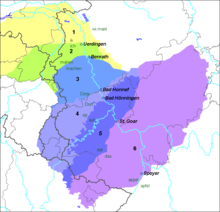The subdivision of West Central German into a series of dialects, according to the differing extent of the High German consonant shift, is particularly pronounced. It known as the Rhenish fan (German: Rheinischer Fächer, Dutch: Rijnlandse waaier) because on the map of dialect boundaries, the lines form a fan shape.[1] Here, no fewer than eight isoglosses, named after places on the Rhine River, run roughly west to east. They partially merge into a simpler system of boundaries in East Central German. The table below lists the isoglosses (bold, in light fields) and the main resulting dialects (italics, in dark fields), arranged from north to south.
Chart

Low Franconian:
1 North Low Franconian
2 South Low Franconian
West Central German:
3 Ripuarian Franconian
4 & 5 Mosel Franconian
6 Rhenish Franconian
| Dialects and isoglosses of the Rhenish fan (Arranged from north to south: dialects in dark fields, isoglosses in light fields)[n 1][2][3] | ||
| North Low Franconian (Kleverlandish, East Bergish) / Low German | ||
|---|---|---|
| Uerdingen line (Uerdingen) (Ürdinger Linie) | ik/ick | ich |
| South Low Franconian (Limburgish) | ||
| Benrath line (Benrather Linie) (Boundary: Low German — Central German) | maken | machen |
| Ripuarian Franconian (Cologne, Bonn, Aachen) | ||
(Dorp/Dorf-Linie or Eifel-Schranke/Eifelschranke) (State border NRW–RP) | Dorp | Dorf |
| Northern Mosel Franconian (Luxembourgish, Trier) | ||
| up | uf | |
| Southern Mosel Franconian (Koblenz, Saarland) | ||
| Bacharach line (Bacharach) (dat/das-Linie or Hunsrück-Schranke/Hunsrückschranke or Bacharacher Linie) | dat, wat | das, was |
| Rhenish Franconian (Pfälzisch, Frankfurt) | ||
| Speyer line (Speyer) (Speyrer Linie) (Boundary: Central German — Upper German) | Appel | Apfel |
| Germersheim line (Germersheim) (Germersheimer Linie) (Boundary: Central German — Upper German) | Pund | Pfund |
| Upper German | ||
Notes
References
🔥 Top keywords: Main PageSpecial:SearchIndian Premier LeagueWikipedia:Featured picturesPornhubUEFA Champions League2024 Indian Premier LeagueFallout (American TV series)Jontay PorterXXXTentacionAmar Singh ChamkilaFallout (series)Cloud seedingReal Madrid CFCleopatraRama NavamiRichard GaddDeaths in 2024Civil War (film)Shōgun (2024 miniseries)2024 Indian general electionJennifer PanO. J. SimpsonElla PurnellBaby ReindeerCaitlin ClarkLaverne CoxXXX (film series)Facebook2023–24 UEFA Champions LeagueYouTubeCandidates Tournament 2024InstagramList of European Cup and UEFA Champions League finalsJude BellinghamMichael Porter Jr.Andriy LuninCarlo AncelottiBade Miyan Chote Miyan (2024 film)